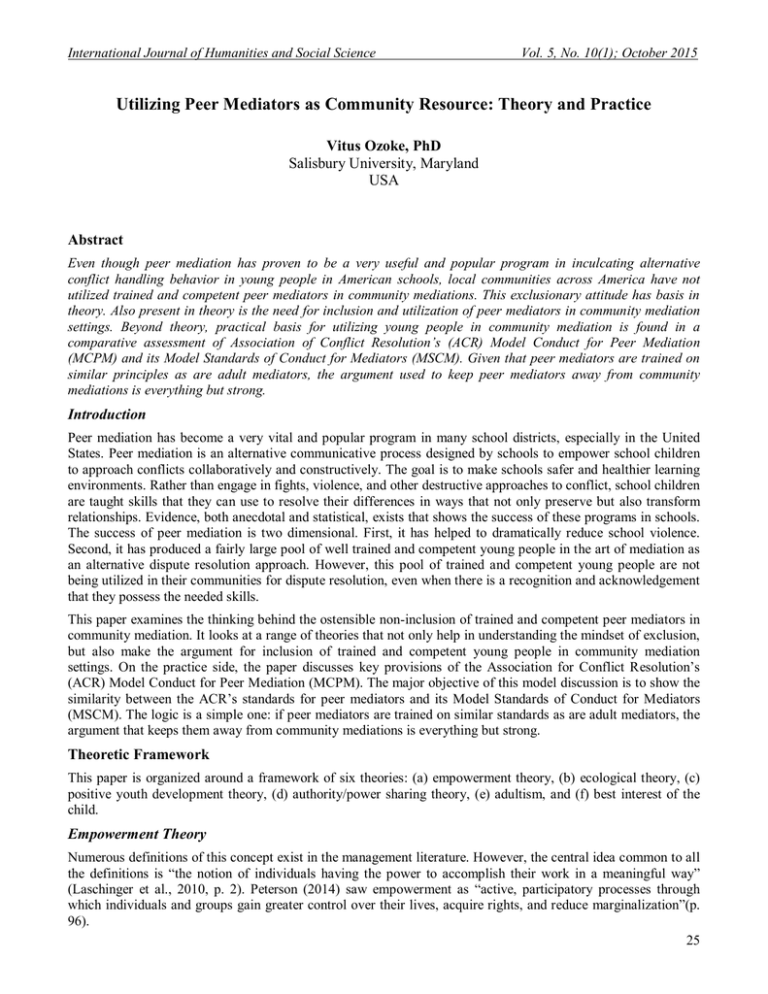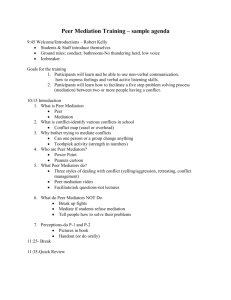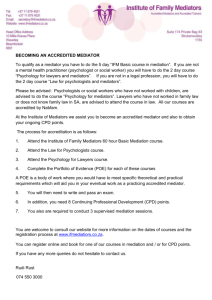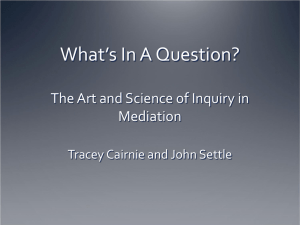Utilizing Peer Mediators as Community Resource: Theory and Practice Abstract
advertisement

International Journal of Humanities and Social Science Vol. 5, No. 10(1); October 2015 Utilizing Peer Mediators as Community Resource: Theory and Practice Vitus Ozoke, PhD Salisbury University, Maryland USA Abstract Even though peer mediation has proven to be a very useful and popular program in inculcating alternative conflict handling behavior in young people in American schools, local communities across America have not utilized trained and competent peer mediators in community mediations. This exclusionary attitude has basis in theory. Also present in theory is the need for inclusion and utilization of peer mediators in community mediation settings. Beyond theory, practical basis for utilizing young people in community mediation is found in a comparative assessment of Association of Conflict Resolution’s (ACR) Model Conduct for Peer Mediation (MCPM) and its Model Standards of Conduct for Mediators (MSCM). Given that peer mediators are trained on similar principles as are adult mediators, the argument used to keep peer mediators away from community mediations is everything but strong. Introduction Peer mediation has become a very vital and popular program in many school districts, especially in the United States. Peer mediation is an alternative communicative process designed by schools to empower school children to approach conflicts collaboratively and constructively. The goal is to make schools safer and healthier learning environments. Rather than engage in fights, violence, and other destructive approaches to conflict, school children are taught skills that they can use to resolve their differences in ways that not only preserve but also transform relationships. Evidence, both anecdotal and statistical, exists that shows the success of these programs in schools. The success of peer mediation is two dimensional. First, it has helped to dramatically reduce school violence. Second, it has produced a fairly large pool of well trained and competent young people in the art of mediation as an alternative dispute resolution approach. However, this pool of trained and competent young people are not being utilized in their communities for dispute resolution, even when there is a recognition and acknowledgement that they possess the needed skills. This paper examines the thinking behind the ostensible non-inclusion of trained and competent peer mediators in community mediation. It looks at a range of theories that not only help in understanding the mindset of exclusion, but also make the argument for inclusion of trained and competent young people in community mediation settings. On the practice side, the paper discusses key provisions of the Association for Conflict Resolution’s (ACR) Model Conduct for Peer Mediation (MCPM). The major objective of this model discussion is to show the similarity between the ACR’s standards for peer mediators and its Model Standards of Conduct for Mediators (MSCM). The logic is a simple one: if peer mediators are trained on similar standards as are adult mediators, the argument that keeps them away from community mediations is everything but strong. Theoretic Framework This paper is organized around a framework of six theories: (a) empowerment theory, (b) ecological theory, (c) positive youth development theory, (d) authority/power sharing theory, (e) adultism, and (f) best interest of the child. Empowerment Theory Numerous definitions of this concept exist in the management literature. However, the central idea common to all the definitions is “the notion of individuals having the power to accomplish their work in a meaningful way” (Laschinger et al., 2010, p. 2). Peterson (2014) saw empowerment as “active, participatory processes through which individuals and groups gain greater control over their lives, acquire rights, and reduce marginalization”(p. 96). 25 ISSN 2220-8488 (Print), 2221-0989 (Online) ©Center for Promoting Ideas, USA www.ijhssnet.com Empowerment is so important a construct that it has gained recognition in official statements of the World Health Organization and the United Nations (Peterson, 2014; Capone & Petrillo, 2013; Fawcett et al., 2010). In the field of community psychology and allied disciplines, empowerment is a strength-based approach that highlights the ability of people in complex life circumstances to identify and vigorously pursue solutions to the daunting challenges they face (Peterson, 2014; Prati& Zani, 2013; Ozer et al., 2013; Baxamusa, 2008). It results in opportunity for the exercise of personal agency (Faulkner, 2001; Wallerstein, 1992). According to Zimmerman (2000), empowering processes are those that present opportunities for the enhancement of confidence and capabilities, the learning and practicing of skills, and the exertion of control and influence over decisions. Empowerment for adolescents may include the opportunity for interacting with adults and making actual contributions to their community. A truly empowering process for adolescents must provide them the opportunity to develop the cognitive and behavioral competencies which they need to be able to critically understand their social contexts, become critical decision makers and independent problem solvers (Zimmerman, 2000; 1995). When young people are empowered by being offered those opportunities for exercising responsibility, including independent decision making, they not only become more innovative and productive, but they also develop a stronger sense of connection to their community (Zeldin, McDonald, Topitzes, & Calvert, 2000). Ecological Theory Bronfenbrenner’s (1979) ecological theory is equally apt in explaining the function of several levels of social context and organization in youth development. He designated these multiple levels as the micro, meso-, exo-, macro-, and chrono- csystems. The microsystem embodies the family, school, neighborhood, and other sites where youth may have interaction with both peers and adults. The mesosystem represents relationships and interactions existing across two or more microsystems (Bronfenbrenner, 1979; Zimmerman et al., 2011). So, mediation skills acquired in school and peer settings must as a matter of ecological imperative interact with other sites in the microsystem, including, and even most importantly, the community. Positive Youth Development The combined effect of empowerment and ecological theories is positive youth development. When youth are empowered across the multiple levels of ecological interactions, the result is a positively developed youth force (Zimmerman et al., 2011). Research evidence exists that confirms that participation in activities that create opportunities for youth to develop social and cognitive skills, a sense of empowerment and associated competence, and involvement in diverse prosocial activities, play active roles in overall positive youth development (Zimmerman & Maton, 1992; Furstenberg & Hughes, 1995; Ramirez-Valles, Zimmerman, & Juarez, 2000; Zimmerman et al., 2011). Similar studies also suggest that involvement in out-of-school activities provides young people with positive social attachments, self-confidence, and support (Zimmerman et al., 2011; Catalano et al., 1996). These are vital resources for the development of social, cognitive, academic, and emotional skills. They can also help to close areas of skill deficits and strengthen youth connections with positive adult and community institutions (Marsh, 1992; Roth & Brooks-Gunn, 2000; Wallace & Williams, 1997; National Research Council and Institute of Medicine [NRC/IOM], 2002). Marsh (1992) attributed these effects to self-concept and sense of control which are nurtured through youth participation in out-of-school program (Zimmerman et al., 2011). According to the NRC/IOM (2002), there are eight features of positive youth development settings: appropriate structure, support for efficacy, positive norms, opportunities for belonging and skill building, supportive relationships, safety, and integration with family, school, and community. These settings, according to Zimmerman et al. (2011), provide useful opportunities for young people to interact with positive adult role models and develop vital skills. To meet the ultimate goal of positive youth development, however, the opportunities articulated by empowerment and ecological theories must allow, not just the participation of young people, but even more significantly, young people’s contributions and control (Zimmerman et al., 2011) Authority/Power Sharing There has been some recognition in recent years by policymakers and educators of the need to involve young people in community service activities and public problem solving as a sure path to the reengagement of youth in the community (Bickmore, 2001; Hepburn, 1997). The scope of peer mediation, as a process that involves the delegation of authority and responsibilities for problem solving, extends well beyond skill acquisition. 26 International Journal of Humanities and Social Science Vol. 5, No. 10(1); October 2015 According to Bickmore (2001), when peer mediators are allowed a share of power and authority – by practicing autonomously – they are “more likely to internalize the values – such as nonviolence and a sense of themselves as citizens who are capable and responsible” (p. 155). Students, including those engaged in peer mediation, need to feel a part of the system of justice. To do this, they should be allowed the opportunity to be a part of the process of tackling the problems that exist in the school settings. Apart from the sense of empowerment that comes with it, young people gain experience in the frustrations and complications of democratic decision making (National Council for the Social Studies Statement [NCSS], 1979). The NCSS (1979), in its common ideal of citizenship education, maintained the concept that democracy will be practiced as a way of life in schools. Using that as a conceptual framework, Bickmore (2001) identified three central components of democratic education: modeling, critical reasoning, and sharing authority with students (p. 138). Democratic modeling in educational context calls for the enactment of basic principles of democracy in the school systems, including the involvement of all stakeholders in collective decision making. Critical reasoning is achieved when students learn to listen respectfully to different perspectives and to analyze problems and solutions. Shared authority entails the active involvement of students as a “‘part of the system of justice’ in the school, rather than teaching them only to obey rules made and enforced by others” (Bickmore, 2001, p. 138). Democracy, by definition, requires collective decision making. It is a system that guarantees to any citizen the power to influence and to participate in the making of some of the rules by which he or she is governed. When young people are allowed the opportunity to participate in the critical discussion of issues affecting them, they develop citizenship-relevant capacities for independent thought (Battistoni, 1997; Hahn, 1996; Bickmore, 2001). Doubtlessly, conflict resolution education is a form of education for citizenship. It helps students develop some vital skills and capacities necessary for citizen activity. It also inculcates in them ideal behavioral values for citizenship. Certainly, peer mediation program is a type of conflict resolution education. It is also a form of service learning, involving not just instructions and training, but also the creation of active roles for peer participants. Indeed, one of the major goals of service learning is to give students nontraditional responsibilities outside the classroom. According to the Constitutional Rights Foundation (1993), service learning programs involve very carefully organized service experiences that address actual community needs, as well as extend what is taught in the school beyond the classroom, and ultimately foster a sense of “caring for others.” (p. 2). Peer mediation provides a real and useful platform for students to share authority with adult school personnel for solving real problem in their schools. As Bickmore (2001) noted, these are “challenges that also arise outside in the adult political community” (p. 154). If only adults would be willing to share power with young people, by shifting emphasis from merely raising young people’s self-esteem to increasing their power, that shift would allow the “exuberance, insight, and creativity of young people to contribute to bettering all our lives” (Creighton & Kivel, 1992, p. 61) Adultism As a matter of social reality, young people are rarely actively involved in processes that affect them. Yet, as noted by Nessel (1988), the same society that shuts young people out in processes that affect them expect them to suddenly emerge as “full-blown empowered adults, integrated into the social context and prepared to make decisions” (p. 25). This view is echoed by Close and Lechman (1997) who observed that as a society, we “shut young people out, especially urban youth, and then we want them to be well adjusted and function in a world that does not treat them fairly” (p. 12). Creighton and Kivel (1992) viewed this treatment as a form of adultism, which they also saw as a form of abuse. They operated from the premise that if abuse was defined as “restricting, controlling, humiliating, or hurting another, it’s clear that abuse is a daily experience for young people. We have a new word for it: adultism.” (p. 4). Children and young people are a socially silenced group (Alldred, 1999). They are a muted group who are denied participation in matters that are considered the exclusive sphere of adults on the basis of their supposed incompetence and immaturity (Mason and Steadman, 1997; Roche, 1999). Studies that have taken a rather more constructivist than essentialist approach to childhood have insisted that, while immaturity is a biological reality, childhood and the meanings that go with it are cultural facts (James &Prout, 1990; Gittins, 1988; Qvortrup, 1993). In those studies, submittedSclater and Piper (2001), there has been a major concern over the exclusion of children as “social actors from sociological theory and policy initiatives because of the implicit view of children as the passive recipients of parental behaviors, family structures or social forces.” (p. 419). 27 ISSN 2220-8488 (Print), 2221-0989 (Online) ©Center for Promoting Ideas, USA www.ijhssnet.com This view of children’s capacities is consistent with the nebulous best interest welfare discourse, constructed in line with adult agendas that reinforce the claim of the structural powerlessness of children in relation to adults (Sclater& Piper, 2001; Kitzinger, 1998). Simply stated, adults just do not believe that adolescents have something to teach them. Close and Lechman (1997) cynically summed it up: “Poor training by adults is tolerated but excellent training by students is open to question by those who refuse to accept youth leadership” (p. 12). They also noted that the WAVE program’s student-as-trainer model has run into “skeptics in the education and conflict resolution fields who do not believe that students can or should be teachers of other students and adults” (Close &Lechman, 1997, p.13). Yet, WAVE’s continued success “contradicts the beliefs of the naysayers and those who practice adultism” (p. 14). Best Interest of the Child The best interest of the child, the so-called welfare principle, is, in some major ways, related to the theory of adultism. It is a very pervasive concept, with presence in both international declarations of rights and domestic family laws. For example, article 3(1) of The UN Convention on the Rights of the Child reads. In all actions concerning children, whether undertaken by public or private social welfare institutions, courts of law, administrative authorities or legislative bodies, the best interest of the child shall be a primary consideration (see Sclater & Piper, 2001, p. 409-410; Rosembaum & Newell, 1991). However, even with the best interest of the child as the focal point of that Convention, the welfare principle has been described as lacking in clear and specific content (Kelly, 1997; Alston, 1994). Its meaning is not just fluid and value-laden, it can also serve as a convenient cover for “bias, paternalism, and capricious decision-making” (Parker, 1994, p. 26). Model Conduct for Peer Mediation In 2006, the Education Section of the Association for Conflict Resolution (ACR) convened its Peer Mediation Standards Committee for the purpose of updating and expanding the “Recommended Standards for School-Based Peer Mediation Programs” developed in 1996 by the Standards Committee of the National Association of Mediation in Education (a forerunner of ACR). According to the ACR report, following those standards of conduct in peer mediation ensures that the integrity of the mediation process is maintained. It also ensures that peer mediators conduct themselves in a manner that not only guarantees mediator competence, but also instills confidence in peer mediation as a dispute handling approach (ACR, 2007, p. 4) The ACR Model Conduct for Peer Mediators is not an isolated document. It is consistent with, and reflects, the Model Standards of Conduct for Mediators established by the Joint Committee of the American Bar Association Section of Dispute Resolution, the American Arbitration Association, and the ACR. To directly quote the ACR, “The Model Standards of Conduct for Peer Mediators is consistent in format and general philosophy with the adult Model Standards of Conduct for Mediators, but it has been adapted for peer mediators” (ACR, 2007, p. 5). Of course, the adaptation is necessary given the context and demographic covered by school-based peer mediations; nonetheless, as stated by the ACR, both standards are “consistent in format and general philosophy” (ACR, 2007, p. 5). The logic of a Model Conduct for Peer Mediators that is consistent with standard of conduct for adult mediators in adult settings is that young people who are trained on this Model are equipped with the core skills and ethics of mediation. Stated differently, the Model Conduct for Peer Mediation exposes young peer mediators to the same fundamental competences and ethics of mediation as are adult mediators in traditional, non-peer, mediation settings. In this logic lies the strongest argument for the transference of peer mediation skills and competences to family disputes. This being the case, it is my judgment that an extensive discussion of key provisions of the Model Conduct for Peer Mediation is in order. I have therefore, selected for discussion the articulations of the Model in the following key areas: (a) Self-determination, (b) Impartiality, (c) Conflicts of interest, (d) Competence, (e) Confidentiality, and (f) Quality of process. Self-Determination According to the Model, a mediator is required to conduct mediation on the basis and principle of the disputants’ self-determination (ACR, 2007). The Model goes on to define self-determination as disputants’ ability to “participate voluntarily and make voluntary choices for themselves in mediation without pressure from administrators, mediators or others.” (ACR, 2007, p. 6). 28 International Journal of Humanities and Social Science Vol. 5, No. 10(1); October 2015 This principle of voluntariness precludes a mediator from interfering with parties’ self-determination for whatever reason, “including getting the parties to reach agreement” (p. 6). But for the expression “the administrators” in the above articulation of the principle of self-determination, the provision could easily pass for the standard language in a traditional mediation standards. With this provision, peer mediators are told in no uncertain language that mediation is a voluntary process, driven by parties’ self-determination. It is not a coerced process. Impartiality The Model insists that a mediator conduct mediation in an impartial manner. Impartiality, according to the Model means “freedom from favoritism, bias or prejudice” (p. 6). Not only should the mediator’s agreement to mediate be conditioned on his or her ability to do so impartially, the mediator must avoid conducting the mediation in any manner that gives the appearance of impartiality. It is not just actual impartiality; it is also the perception of impartiality. To meet this goal, the mediator must avoid anything that presents the appearance of “taking a side or showing favor to one of the disputants, including action based on the disputants’ personal characteristics, background, values, beliefs or the way they act during the mediation.” (p. 6). The Model insists that the mediator must withdraw from mediation at any time he or she can no longer guarantee his or her impartiality. This is a standard requirement in traditional mediator ethic. To insist on the same standard for peer mediators is to demand the same level of responsibility and competence as adult mediators in non-peer settings from peer mediators. Conflicts of Interest This is another major area of ethical conundrum for mediators generally. As in impartiality, conflict of interest requires that mediators recuse themselves from mediation, not just when there is actual conflict of interest, but also when there is the appearance of one. Conflicts of interest situations arise when a mediator is personally connected with a party to the dispute or the dispute itself that creates the appearance of partiality. As part of the full disclosure required to avoid conflict of interest in peer mediation, the Model requires that, before agreeing to serve as a peer mediator, a peer mediator must disclose to the peer mediation program coordinator any past, existing or potential relationship or connection he or she may have with any of the parties’ to the conflict, or the conflict itself (p. 6). According to the Model, there are some connections that are too close that the mediator cannot conceivably be expected to function impartially. In those kinds of cases, the mediator must decline to mediate. However, not all situations of seeming conflict of interest are actual conflict of interest. The Model, therefore, recognizes that when cultural expectations do not see a relationship as presenting a conflict of interest, and with the agreement of the parties, the mediator may mediate. Should a situation arise in which the mediator is oblivious of the relationship or connection prior to commencing mediation, but becomes aware of it after the mediation is already afoot, the peer mediator should advise the peer mediation program coordinator and the parties as soon as he or she becomes aware of the relationship or connection. Such mediation may continue if parties agree, and if the integrity of the process will not be compromised. To further guard the integrity of the mediation process, the Model requires that even post-mediation, the peer mediator should not engage in any behavior or conduct that gives the appearance of partiality to any of the parties to an already concluded mediation. These are no doubt very serious matters of process integrity. That peer mediators are held to these standards is an eloquent testament to the seriousness and integrity of the peer mediation process. Competence Competence is a very critical factor in any service delivery, and mediation – traditional or peer – is no exception. Competence in mediation involves “training, cultural understanding, mediation skills, and experience” (p. 7). The Model demands that peer mediators maintain competence as a matter of obligation. They must decline a case if they believe that the case involves and requires skill beyond their own expertise. The Model takes the issue of competence so seriously that it does not overlook it on the excuse that mediation was already underway when lack of competence was discovered. At any point in a peer mediation process that the mediator realizes his or lack of competence, the mediator has an obligation to notify the peer mediation program coordinator so that a new mediator with competence is brought in or assistance is provided for the original mediator. 29 ISSN 2220-8488 (Print), 2221-0989 (Online) ©Center for Promoting Ideas, USA www.ijhssnet.com Competence in peer mediation is a specific type of competence, different from other areas of competence that the student may possess. It requires specific type of training. Therefore, student peer mediators should be able to see their roles in peer mediation and any other student leadership roles as distinct. The Model treats student peer mediators as role models for other students, and demands of them outstanding exemplariness in conduct and observance of school rules and disciplinary policies. As players in the mediation program, peer mediators are expected to respect and observe policies and procedures relative to the program, including bringing their own interpersonal disputes to the program when needed. Confidentiality Confidentiality is a major requirement of mediation. It is arguable that it is the element of confidentiality that offers the greatest attraction in mediation for disputants who opt for it over traditional, formal, and open dispute resolution approaches. The Model treats confidentiality with no less salience for peer mediation. At the beginning of the mediation, the peer mediator is obligated to explain to disputants the concept of confidentiality and the exceptions to it. As in traditional adult mediation in adult contexts, the peer mediator is obligated to “keep confidential everything said, done and written during the mediation, unless required by school policy and mediation procedures or as agreed to by the disputants.” (p. 8). The same standard of near inviolability to which confidentiality is held in traditional mediation also applies in peer mediation. A peer mediator is precluded from disclosing to “program administrators or other referring parties what was said or done in mediation, but they may report whether the disputants came to mediation and whether they reached an agreement.” (p. 8). Should a situation arise in mediation that meets exception to confidentiality requirement, the peer mediator should take necessary and appropriate steps to meet the balance of the exception and the overall integrity of the process, including reporting such exceptional situation to the program coordinator and, if warranted, postponing or ending the process. To advance the mediation program, a peer mediator is allowed to share with the program coordinator and other program participants what transpired during the mediation purely for training and debriefing, provided that the mediator takes steps to preserve the privacy and confidentiality of the parties as much as possible (p. 8). Also, should a peer mediator meet in private sessions with any party during mediation, otherwise known as caucusing, he or she is under an obligation not to disclose, either directly or indirectly, any information disclosed and learned during those private sessions to any other party without the prior consent the first party. No doubt, these are the standard confidentiality requirements in traditional mediation. To require these same standards of peer mediators is clearly indicates that, practically, the line between the ethics and skills of both mediation practices may not be too clear, and certainly not significant. Quality of the Process To ensure that peer mediation is guided by the principles of fairness and equity, the Model requires that a mediator conduct mediation “fairly, respectfully and in a timely manner consistent with these standards.” (p. 8). A mediator meets the demands of equity and fairness by, among others, ensuring that the process of mediation guarantees to all disputants the opportunity “to speak, to be heard, and to propose, evaluate, reject or accept potential solutions to their conflict.” (p. 8). Honesty is at the foundation of a fair, credible, and meaningful mediation. The Model requires a peer mediator to encourage honesty among all parties, including mediators themselves. Should a mediator believe that a disputant has engaged or engages in actions that make impossible the conduct of mediation that is consistent with the standards, including the requirement of honesty as part of a fair and equitable process, the mediator should postpone the process, withdraw from it, or end it altogether? Sometimes, a party to mediation may have difficulty comprehending the issues in dispute, the mediation process, or the different agreement options. Also, a party may have difficulty taking part in the mediation. In the event of any of these scenarios, the Model requires the peer mediator to consult with the co-mediator, where one exists, and/or the program coordinator to determine an appropriate alternative course of action to assist the party in difficulty, or if the process should be discontinued entirely (p. 9). What crystalizes from the above discussions of the key provisions of the ACR’s Model Conduct for Peer Mediators is how the Model is a very close, if not perfect, reflection of the standards for traditional mediation in non-peer, non-school-based settings. 30 International Journal of Humanities and Social Science Vol. 5, No. 10(1); October 2015 If the Model imposes on peer mediators same requirements of competence, confidentiality, quality of process, impartiality, conflicts of interests, and self-determination, as are required in traditional mediation, then, the logic that precludes trained and competent peer mediators from conducting mediations in non-school contexts, especially in their community settings, is a flawed logic. It is a logic that is anchored and perpetuated on the notions of paternalism and adultism. Conclusion This paper set out to accomplish the dual task of weaving both theory and practice into a common outcome. On theoretic level, the paper has used theories to accomplish two things: (1) to examine the thinking that excludes young people who have been trained to competence in peer mediation from involvement in community mediations; and (2) to advance the argument for the inclusion of such young people in community mediation. This it did with fairly detailed discussion of the following theories: (a) empowerment theory, (b) ecological theory, (c) positive youth development theory, (d) authority/power sharing theory, (e) adultism, and (f) best interest of the child. On the level of practice, the paper has used a comparative review of Association of Conflict Resolution’s Model Conduct for Peer Mediation (MCPM) and its Model Standards of Conduct for Mediators (MSCM) to assess the degree of similarity in standards between peer and conventional (adult) mediations. From both theory and practice, the paper has made the case for the utilization of young people who have been trained in peer mediation in community mediations. References Alston, P. (1994). The best interest principle: Towards a reconciliation of culture and human rights. International Journal of Law and the Family, 8, 1-25. Alldred, P. (1999). Ethnography and discourse analysis: Dilemmas in representing the voices of children. In J. Ribbens & R. Edwards (Eds.), Feminist dilemmas in qualitative research: Public voices, private lives (pp. 147-170). London: Sage Association for Conflict Resolution. (2007). Recommended standards for school-based peer mediation programs 2007. Retrieved August 2, 2014, from http://www.mediate.com/acreducation/ . Battistoni, R. (1997). Service learning and democratic citizenship. Theory into Practice, 36(3), 150-156. Baxamusa, M. H. (2008). Empowering communities through deliberation: The model of community benefits agreements. Journal of Planning Education and Research, 27, 261 276. Bickmore, K. (2001). Winning against violent environments: High school students are good teachers of peace. Thresholds in Education, 19, 3. Bronfenbrenner, U. (1979). The ecology of human development. Cambridge, MA: Harvard University Press. Capone, V., & Petrillo, G. (2013). Health Promotion in international documents: Strengths and weaknesses from the perspective of community empowerment. Journal of Community & Applied Social Psychology, 23, 98–114. Catalano, R. F., Kosterman, R., Hawkins, J. D., Newcomb, M. D., & Abbott, R. D. (1996). Modeling the etiology of adolescent substance use: A test of the social development model. Journal of Drug Issues, 26(2), 429-455. Close, C.L., & Lechman, K. (1997). Fostering youth leadership: Students train students and adults in conflict resolution. Theory into Practice, 36(1), 11-16. Constitutional Rights Foundation. (1993). Service learning in the social studies. Chicago, IL: Author. Creighton, A., & Kivel P. (1992). Helping teens stop violence. Alameda, CA: Hunter House Faulkner, M. (2001). A measure of patient empowerment in hospital environments catering for older people. Journal of Advanced Nursing, 34, 676-686. Fawcett, S., Abeykoon, P., Arora, M., Dobe, M., Galloway-Gilliam, L., Liburd, L., et al. (2010). Constructing an action agenda for community empowerment at the 7th Global Conference on Health Promotion in Nairobi. Global Health Promotion, 17, 52–56. Furstenberg, F. F., Jr., & Hughes, M. E. (1995). Social capital and successful development among at-risk youth. Journal of Marriage and the Family, 57, 580-592. Gittins, D. (1998). The child in question. Palgrave Macmillan Hahn, C. (1996). Empirical research on issues-centered social studies. In Evans, R., & Saxe, D., (Eds.). The Handbook on issue-centered social studies, Washington, DC: National Council for the Social Studies, 25-41. Hepburn, M. (1997). Service learning in civic education: A concept with long, sturdy roots. Theory into Practice, 36(3), 136-142. 31 ISSN 2220-8488 (Print), 2221-0989 (Online) ©Center for Promoting Ideas, USA www.ijhssnet.com James, A., & Prout, A. (1998). Constructing and reconstructing childhood: Contemporary issues in the sociological study of childhood. Bristol, PA: Routledge. Kelly, J. (1997). The best interest of the child: A concept in search of meaning. Family and Conciliation Courts Review, 35, 377-387. Kitzinger, J. (1998). Defending innocence: Ideologies of Childhood. Feminist Review, 28, 77-87. Laschinger, H.K., Gilbert, S., Smith, L.M., & Leslie, K. (2010). Toward a comprehensive theory of nurse/patient empowerment: Applying Kanter’s empowerment theory to patient care. Journal of Nursing Management, 18, 4-13. Marsh, H. W. (1992). Extracurricular activities: Beneficial extension of the traditional curriculum or subversion of academic goals. Journal of Educational Psychology, 84, 553 -562. Mason, J., & Steadman, B. (1997). The significance of the conceptualization of childhood for child protection policy. Family Matters, 46, 31-36. National Council for the Social Studies. (1979). Democratization of schools: Position statement, approved by NCSS board of directors. Washington, DC: Author. National Research Council and Institute of Medicine. (2002). Community programs to promote youth development (J. Eccles & J. A. Gootman, Eds.). Washington, DC: National Academy Press. Nessel, L. (1988). A coalition approach to enhancing youth empowerment. Social Policy, 25-27. Ozer, E. J., Newlan, S., Douglas, L., & Hubbard, E. (2013). ‘‘Bounded’’ empowerment: Analyzing tensions in the practice of youth-led participatory research in urban public schools. American Journal of Community Psychology, 52, 13–26. Parker, S. (1994). The best interest of the child – principles and problems. International Journal of Law and the Family, 8, 27-29. Peterson, N.A (2014). Empowerment theory: Clarifying the nature of higher-order multidimensional constructs. American Journal of Community Psychology, 53, 96–108. Prati, G., & Zani, B. (2013). The relationship between psychological empowerment and organizational identification. Journal of Community Psychology, 41, 851–866. Qvortrup, J. (1993). Childhood as a social phenomenon: Lessons from an international project. Childhood, 1, 119-124. Ramirez-Valles, J., Zimmerman, M. A., & Juarez, L. (2000). Gender differences of neighborhood and social control processes: A study of the timing of first intercourse among urban African-American youth. Youth & Society, 33, 418-441. Roche, J. (1999). Children: Rights, participation, and citizenship. Childhood, 6, 475-493. Rosenbaum, M., & Newell, P. (1991). Taking children seriously: A proposal for a children’s rights commissioner. Calouste Gulbenkian Foundation Roth, J., & Brooks-Gunn, J. (2000). What do adolescents need for healthy development? Implications for youth policy. Social Policy Report, 14(2), 3-19. Sclater, S.D., & Piper, C. (2001). Social exclusion and the welfare of the child. Journal of Law and Society, 28(3), 409429. Wallace, J. M., & Williams, D. R. (1997). Religion and adolescent health compromising behavior. In J. Schulenberg, J. L. Maggs, & K. Hurrelmann (Eds.), Health risks and developmental transitions during adolescence (pp. 444468). New York: Cambridge University Press. Wallerstein, N. (1992). Powerless, empowerment and health: Implications for health promotion programs. American Journal of Health Promotion, 6(3), 197-205. Zeldin, S., McDaniel, A., Topitzes, D., & Calvert, M. (2000). Youth in decision making: A study on the impacts of youth on adults and organizations. Washington, DC: National 4-H Council. Zimmerman, M. A. (1995). Psychological empowerment: Issues and illustrations. American Journal of Community Psychology, 23, 581-599. Zimmerman, M. A. (2000). Empowerment theory: Psychological, organizational and community levels of analysis. In J. Rappaport & E. Seidman (Eds.), Handbook of community psychology (chap. 2, pp. 43-63). New York: Plenum. Zimmerman, M. A., &Maton, K. I. (1992). Lifestyle and substance use among urban black male adolescents: A cluster analytic approach. American Journal of Community Psychology, 20, 121-138. Zimmerman, M.A., Stewart, S.E., Morrel-Samuels, S., Franzen, S., & Reischl, T.M. (2011). Youth empowerment solutions for peaceful communities: Combining theory and practice in a community-level violence prevention curriculum. Health Promotion Practice, 12 (3), 425-439. 32







